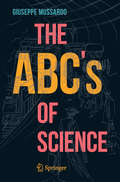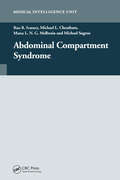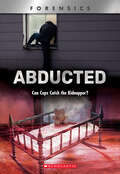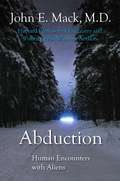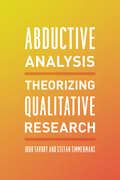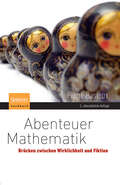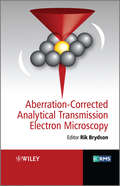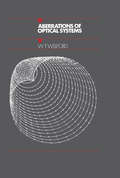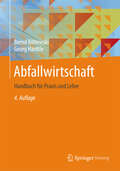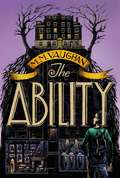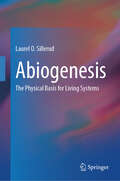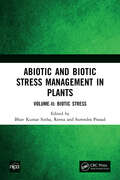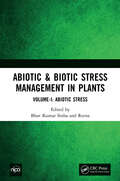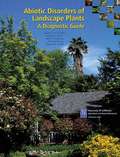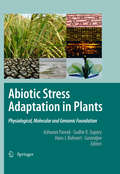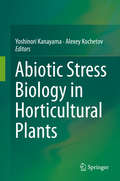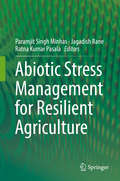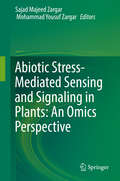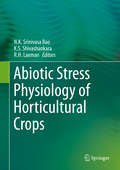- Table View
- List View
The ABC’s of Science
by Giuseppe MussardoScience, with its inherent tension between the known and the unknown, is an inexhaustible mine of great stories. Collected here are twenty-six among the most enchanting tales, one for each letter of the alphabet: the main characters are scientists of the highest caliber most of whom, however, are unknown to the general public.This book goes from A to Z. The letter A stands for Abel, the great Norwegian mathematician, here involved in an elliptic thriller about a fundamental theorem of mathematics, while the letter Z refers to Absolute Zero, the ultimate and lowest temperature limit, - 273,15 degrees Celsius, a value that is tremendously cooler than the most remote corner of the Universe: the race to reach this final outpost of coldness is not yet complete, but, similarly to the history books of polar explorations at the beginning of the 20th century, its pages record successes, failures, fierce rivalries and tragic desperations. In between the A and the Z, the other letters of the alphabet are similar to the various stages of a very fascinating journey along the paths of science, a journey in the company of a very unique set of characters as eccentric and peculiar as those in Ulysses by James Joyce: the French astronomer who lost everything, even his mind, to chase the transits of Venus; the caustic Austrian scientist who, perfectly at ease with both the laws of psychoanalysis and quantum mechanics, revealed the hidden secrets of dreams and the periodic table of chemical elements; the young Indian astrophysicist who was the first to understand how a star dies, suffering the ferocious opposition of his mentor for this discovery. Or the Hungarian physicist who struggled with his melancholy in the shadows of the desert of Los Alamos; or the French scholar who was forced to hide her femininity behind a false identity so as to publish fundamental theorems on prime numbers. And so on and so forth.Twenty-six stories, which reveal the most authentic atmosphere of science and the lives of some of its main players: each story can be read in quite a short period of time -- basically the time it takes to get on and off the train between two metro stations. Largely independent from one another, these twenty-six stories make the book a harmonious polyphony of several voices: the reader can invent his/her own very personal order for the chapters simply by ordering the sequence of letters differently. For an elementary law of Mathematics, this can give rise to an astronomically large number of possible books -- all the same, but - then again - all different. This book is therefore the ideal companion for an infinite number of real or metaphoric journeys.
Abdominal Compartment Syndrome
by Rao IvaturyFirst suggested in 1863 by Marey, abdominal compartment syndrome, (ACS), is a constellation of the physiologic sequelae of increased intra-abdominal pressure, (IAP), termed intra-abdominal hypertension, (IAH). Recent observations suggest an increasing frequency of this complication in all types of patients, neonates to the elderly and in diverse cl
Abdominal Imaging (Learning Imaging Ser.)
by Pablo R. Ros Bernd HammIn this book a team of leading experts come together to provide a comprehensive overview of modern imaging of the abdomen and pelvis, with detailed sections on both gastrointestinal and genitourinary imaging. Each chapter has an identical structure and focuses on a particular organ or organ system, allowing the reader to approach the field one topic at a time. Indications for a variety of imaging techniques and examination protocols are clearly described, and the imaging features of normal anatomy and pathologic entities are depicted in an abundance of high-quality images. Care is taken to consider all recent technical developments and new indications, and the diagnostic performance of different imaging modalities is carefully compared. It is anticipated that this book will come to be regarded as the standard work of reference on abdominal and pelvic radiology.
Abducted: Can Cops Catch the Kidnapper? (XBooks: Forensics)
by Diane WebberCan the kidnapper be caught?Charles Lindbergh was a very famous public figure whose son was kidnapped from his crib. Much of the investigation was based on a series of ransom notes which ultimately led to the conviction of a suspect.High-interest topics, real stories, engaging design, and astonishing photos are the building blocks of the XBooks, a new series of books designed to engage and motivate reluctant and enthusiastic readers alike. How can DNA help a convicted person prove their innocence? How did a burglar steal from a store without leaving any fingerprints? Why was the tiny town in Hardin, Missouri, awash with skeletons after a huge flood? With topics based in science, these action-packed books will help students unlock the power and pleasure of reading... and always ask for more!
Abduction: Human Encounters with Aliens
by MackA Harvard psychiatrist, the author of A Prince of Our Disorder, presents accounts of alien abduction taken from the more than sixty cases he has investigated and examines the implications for our identity as a species.
Abduction: Human Encounters with Aliens
by John E. MackJohn E. Mack, M.D., has investigated nearly one hundred cases of alien abduction and has conducted hundreds of hours of interviews and treatment. He takes his clients' accounts seriously, and in Abduction he makes clear why he believes their testimony may transform the foundations of human thought as profoundly as did Copernicus's proof that the earth is not the center of the universe. Writing with the authority and insight that have been the hallmarks of his distinguished career as a psychiatrist and writer, Dr. Mack emphasizes his clients' psychological and spiritual transformations, and he illuminates the vast implications of the abduction experience for his understanding of human psychology and of our identity as a species on this planet.<P> Never before has a book on alien abductions included case histories from such a wide cross-section of men and women from a variety of geographic regions and economic and educational levels, who had never met one another or compared their stories. Abduction will persuade every reader with an open mind that these accounts are not hallucinations, not dreams, but real experiences. Throughout Abduction, Dr. Mack focuses especially on the supportive and collaborative relationship between doctor and client. Here are vivid, dramatic, often inspiring stories of people undergoing - and triumphantly coming to understand - the greatest traumas of their lives. In Dr. Mack's retellings, these accounts of alien abduction become human interest stories of stirring emotional power. Eye-opening, provocative, and above all authoritative, Abduction makes an important contribution to the literature on human consciousness.
Abductive Analysis: Theorizing Qualitative Research
by Iddo Tavory Stefan TimmermansIn Abductive Analysis, Iddo Tavory and Stefan Timmermans provide a new navigational map for theorizing qualitative research. They outline a way to think about observations, methods, and theories that nurtures theory formation without locking it into predefined conceptual boxes. The book provides novel ways to approach the challenges that plague qualitative researchers across the social sciences--how to conceptualize causality, how to manage the variation of observations, and how to leverage the researcher’s community of inquiry. Abductive Analysis is a landmark work that shows how a pragmatist approach provides a productive and fruitful way to conduct qualitative research.
Abenteuer Mathematik: Brücken zwischen Wirklichkeit und Fiktion
by Pierre BasieuxNicht Mathematik zu betreiben, sondern zu erfahren ist das Abenteuer, das dieses Buch bietet - Denkexpeditionen, deren Ausgangspunkt Fragen sind: Was steckt hinter mathematischen Fiktionen wie den unendlich vielen Stufen des Unendlichen oder dem Letzten Fermatschen Satz? Worin liegt ihre Schönheit, worin ihr Bezug zur Realität? Welchen Köpfen sind solche Ideen entsprungen, welche Schicksale mit ihnen verbunden? Das Buch wurde für die vorliegende 5. Auflage vollständig durchgesehen und aktualisiert.
Abenteuer Zellbiologie - Streifzüge durch die Geschichte
by Helmut PlattnerHelmut Plattner nimmt Sie mit auf eine Zeitreise, die die Entwicklung der Zellbiologie von der Erfindung des Mikroskops bis in unsere Zeit mit ihrem rasanten Fortschritt und dem Nobelpreis Physiologie/Medizin 2019 nachzeichnet. Neben seiner langjährigen Lehrerfahrung schöpft er v. a. daraus, dass er oft als (Zaun-)Gast oder sogar Akteur Teil dieser Entwicklung war. Modellorganismen von unterschiedlichem evolutionärem Niveau waren wichtige Hinweisgeber für Problemlösungen, besonders auch unter Einbeziehung neuer molekularbiologischer Methoden. Der Text ist verständlich geschrieben, zieht anschauliche Vergleiche und bietet Ihnen Anknüpfungspunkte durch bekannte Krankheiten (z. B. die Thematik Malaria und Sichelzellanämie) und prominente Namen. Zahlreiche anschauliche Abbildungen runden den Text ab.
Abenteuer Zellbiologie - Streifzüge durch die Geschichte
by Helmut PlattnerHelmut Plattner nimmt Sie mit auf eine Zeitreise, die die Entwicklung der Zellbiologie von der Erfindung des Mikroskops bis in unsere Zeit mit ihrem rasanten Fortschritt und zahlreichen Nobelpreisen nachzeichnet. Neben seiner langjährigen Lehrerfahrung schöpft er v. a. daraus, dass er oft als Gast oder sogar Akteur Teil dieser Entwicklung war. Modellorganismen von unterschiedlichem evolutionärem Niveau waren wichtige Hinweisgeber für Problemlösungen, besonders auch unter Einbeziehung neuer Methoden einschließlich der Molekularbiologie. Der Text ist verständlich geschrieben, zieht anschauliche Vergleiche und bietet Ihnen Anknüpfungspunkte durch bekannte Krankheiten (z. B. die Thematik Malaria und Sichelzellanämie) und prominente Namen. Zahlreiche anschauliche Abbildungen runden den Text ab.
Aberration-corrected Analytical Electron Microscopy
by Rik BrydsonThe book is concerned with the theory, background, and practical use of transmission electron microscopes with lens correctors that can correct the effects of spherical aberration. The book also covers a comparison with aberration correction in the TEM and applications of analytical aberration corrected STEM in materials science and biology. This book is essential for microscopists involved in nanoscale and materials microanalysis especially those using scanning transmission electron microscopy, and related analytical techniques such as electron diffraction x-ray spectrometry (EDXS) and electron energy loss spectroscopy (EELS).
Aberrations of Optical Systems
by W.T WelfordAlthough the subject of optical design as a branch of applied physics is over one hundred years old, the use of aberration theory has changed considerably. Aberrations of Optical Systems covers elementary optics and aberration theory of various optical systems, including the use of nonaxially symmetric systems and diffractive optical elements in complex designs, such as head-up displays and the increasing use of scanning systems with laser illumination. The book provides the complete range of mathematical tools, formulae, and derivations needed for understanding the process of optical design and for planning optical design programs. While the treatment is mainly based on geometrical optics, some excursions into physical optics are made, particularly in connection with the problems of optical tolerances.
Abfallenergie und Entropiewirtschaft (essentials)
by Wolfgang Fratzscher Klaus MichalekEs wird eine allgemein gültige Definition der Abfallenergie vorgeschlagen. Diese erfordert die Einbeziehung des II. Hauptsatzes der Thermodynamik. Das Auftreten von inneren Nichtumkehrbarkeiten bei allen technischen Prozessen als wesentliche, in den Energiebilanzen nicht sichtbare Verlustquellen führt zu äußeren Verlusten, den Abfallenergien. Die betrachteten Systeme zeigen den Einfluss von Technologie und Bilanzgrenzen auf Art und Größe der Verluste und den Zusammenhang zwischen Primärenergiebilanz, anthropogenen Prozessen und Abfallenergie. So stellt sich die Abfallenergieverwertung als die duale Seite einer allgemeinen energiewirtschaftlichen Betrachtung dar. Wenn man von einem solchen Ansatzpunkt ausgeht, spricht man nach einem Paradigmenwechsel bei der Gestaltung optimaler technischer Prozesse von einer Entropiewirtschaft statt einer Energiewirtschaft.
Abfallwirtschaft: Handbuch für Praxis und Lehre
by Bernd Bilitewski Georg HärdtleIn bewährter Weise beantwortet dieses Standardwerk alle Fragen der täglichen Praxis zum Thema Abfall. Für die Neuauflage haben die Autoren das gesamte Werk auf den neuesten Stand gebracht: die rechtlichen Grundlagen, Angaben zu Abfallmengen und -zusammensetzung, zur Sammlung, zum Umschlag und Transport, zu Recycling und Kosten von Abfallbehandlungsanlagen wurden aktualisiert. Außerdem wurde der Band um eine Zusammenfassung der aktuellen Entwicklungen im Bereich Stoffstrommanagement und um das Thema automatische Sortierung erweitert.
The Ability
by Iacopo Bruno M. M. VaughanDelve into the extraordinary abilities of the twelve-year-old mind in this thrilling start to a middle-grade series that expands the possibilities of power.No one has any confidence in twelve-year-old Christopher Lane. His teachers discount him as a liar and a thief, and his mom doesn't have the energy to deal with him. But a mysterious visit from the Ministry of Education indicates that Chris might have some potential after all: He is invited to attend the prestigious Myers Holt Academy. When Christopher begins at his new school, he is astounded at what he can do. It seems that age twelve is a special time for the human brain, which is capable of remarkable feats--as also evidenced by Chris's peers Ernest and Mortimer Genver, who, at the direction of their vengeful and manipulative mother, are testing the boundaries of the human mind. But all this experimentation has consequences, and Chris soon finds himself forced to face them--or his new life will be over before it can begin.
The Ability
by M. M. Vaughan Iacopo BrunoDelve into the extraordinary abilities of the twelve-year-old mind in this "fast-paced, superhero-tinged spy novel" (Publishers Weekly), the thrilling start to a middle grade series that expands the possibilities of power.No one has any confidence in twelve-year-old Christopher Lane. His teachers discount him as a liar and a thief, and his mom doesn't have the energy to deal with him. But a mysterious visit from the Ministry of Education indicates that Chris might have some potential after all: He is invited to attend the prestigious Myers Holt Academy. When Christopher begins at his new school, he is astounded at what he can do. It seems that age twelve is a special time for the human brain, which is capable of remarkable feats--as also evidenced by Chris's peers Ernest and Mortimer Genver, who, at the direction of their vengeful and manipulative mother, are testing the boundaries of the human mind. But all this experimentation has consequences, and Chris soon finds himself forced to face them--or his new life will be over before it can begin.
Abiogenesis: The Physical Basis for Living Systems
by Laurel O. SillerudThis textbook serves to teach readers about the origins of life, the probabilistic process of self-assembly underpinning all living systems, from a biophysics perspective. The author cohesively summarizes the various organizing principles that led to the development of an ordered physical basis on which the evolution of life operates. This book answers critical questions, such as why life depends on the properties of inanimate objects and how the laws of physics, chemistry, and biology convolved to spontaneously produce the periodic table and, of course, life itself. Readers are provided with an introduction to probability distributions as well as detailed descriptions of important concepts in thermodynamics, statistical mechanics, and quantum mechanics. As the book progresses, an understanding for the inevitability of life is developed through topics such as stellar nucleosynthesis and prebiotic evolution. Each chapter also includes problems for readers to gain a better understanding of the material. This textbook is accessible to students and researchers of all levels and serves as a comprehensive guide on the physics behind abiogenesis.
Abiotic and Biotic Stress Management in Plants: Volume-II: Biotic Stress
by Bhav Kumar SinhaThis book deals with an array of topics in the broad area of biotic stress responses in plants focusing “problems and their management” by selecting some of the widely investigated themes. Such as, Major insect-pest of cereal crops in India and their management, Biotic stresses of major pulse crops and their management strategies, Insect pest of oilseed crops and their management, Biotic stresses of vegetable crops & their management, Insect pests infesting major vegetable crops and their management strategies, Fruit Crops Insect pests and their Biointensive Integrated Pest Management techniques, Mass Trapping of fruit flies using Methyl Eugenol based Traps, Organic means of combating biotic stresses in plants, Nematode problem in pulses and their management, and approaches in pest management of stored grain pests. This book is useful for under-graduate and post-graduate students in Entomology, Plant Pathology, Agronomy, Horticulture, other cognate disciplines of agriculture and allied sciences and other research workers. Note: T& F does not sell or distribute the Hardback in India, Pakistan, Nepal, Bhutan, Bangladesh and Sri Lanka. This title is co-published with NIPA.
Abiotic & Biotic Stress Management in Plants: Volume-I: Abiotic Stress
by Bhav Kumar Sinha ReenaThis book deals with an array of topics in the broad area of abiotic stress responses in plants focusing “problems and their management” by selecting some of the widely investigated themes. Such as, Cell signalling in Plants during abiotic and biotic stress, Salinity stress induced metabolic changes and its management, High temperature stress: responses, mechanism and management, Low temperature stress induced changes in plants and their management, Biotechnological approaches to improve abiotic stress tolerance, Nutritional poverty in wheat under abiotic stress scenario, Strategies for improving soil health under current climate change scenario, Abiotic stress management in Pulse crops, Mitigation strategies of abiotic stress in fruit crops, Impacts of abiotic stress and possible management option in vegetable crops, and Abiotic stress: impact and management in ornamental crops. This book is useful for under-graduate and post-graduate students in Plant Physiology, Biochemistry, agronomy, horticulture, Botany, Environmental sciences and other cognate disciplines of agriculture and allied sciences and other research workers. We fervently believe that this book will provide good information and understanding of abiotic stress problems and their management in plants.Note: T& F does not sell or distribute the Hardback in India, Pakistan, Nepal, Bhutan, Bangladesh and Sri Lanka. This title is co-published with NIPA.
Abiotic Disorders of Landscape Plants: A Diagnostic Guide
by Laurence R. Costello Edward J. Perry Nelda P. Matheny J. Michael Henry Pamela M. GeiselLandscape plants can be injured by biotic and abiotic agents. This book focuses on abiotic disorders such as water deficits, aeration deficits, nutritional deficiencies, specific ion toxicities, pH-related problems, and herbicide injury.
Abiotic Stress Adaptation in Plants: Physiological, Molecular and Genomic Foundation
by Hans J. Bohnert Ashwani Pareek Govindjee S. K. SoporyEnvironmental insults such as extremes of temperature, extremes of water status as well as deteriorating soil conditions pose major threats to agriculture and food security. Employing contemporary tools and techniques from all branches of science, attempts are being made worldwide to understand how plants respond to abiotic stresses with the aim to help manipulate plant performance that will be better suited to withstand these stresses. This book on abiotic stress attempts to search for possible answers to several basic questions related to plant responses towards abiotic stresses. Presented in this book is a holistic view of the general principles of stress perception, signal transduction and regulation of gene expression. Further, chapters analyze not only model systems but extrapolate interpretations obtained from models to crops. Lastly, discusses how stress-tolerant crop or model plants have been or are being raised through plant breeding and genetic engineering approaches. Twenty three chapters, written by international authorities, integrate molecular details with overall plant structure and physiology, in a text-book style, including key references.
Abiotic Stress Biology in Horticultural Plants
by Yoshinori Kanayama Alexey KochetovThe purpose of this publication is to elucidate the biological aspect of the abiotic stress response from the field to the molecular level in horticultural plants. This book is unique in that it concerns the basic aspect of abiotic stress biology and research progress at the molecular level in model plants or major field crops, as it focuses mainly on the abiotic stress response in existing horticultural plants. Many readers interested in plant abiotic stress biology are aware of the application of the latest findings to agricultural production, and this book will have a special appeal for those readers. The book will be of interest to scientists and graduate students who are involved in the research, development, production, processing, and marketing of horticultural products, including those in developing countries who are interested in high tech and advanced science in this field. The application of the latest findings to agricultural production is particularly useful. Stress tolerance mechanisms in horticultural crops are gaining importance, because most agricultural regions are predicted to experience considerably more extreme environmental fluctuations due to global climate change. Further, because of recent progress in next-generation sequencing technologies, the postgenomic era is impending not only in model plants and major cereal crops but also in horticultural crops, which comprise a great diversity of species. This book provides information on the physiological aspects of the abiotic stress response in horticultural plants, which is considered essential for postgenomic research.
Abiotic Stress Management for Resilient Agriculture
by Paramjit Singh Minhas Jagadish Rane Ratna Kumar PasalaThis book offers a state-of-the-art overview of on abiotic stresses in terms of the challenges; scope and opportunities; copping strategies for adaptation and mitigation using novel tools for building resilience in agricultural crops and livestock; as well as for policy implementation. Divided into four major parts: advances and prospects for understanding stress environments; adaptation and mitigation options; crop-based mitigation strategies; and mitigation options in animal husbandry, the book focuses on problem-solving approaches and techniques that are essential for the medium to long-term sustainability of agricultural production systems The synthesis and integration of knowledge and experiences of specialists from different disciplines offers new perspectives in the versatile field of abiotic stress management, and as such is useful for various stakeholders, including agricultural students, scientists, environmentalists, policymakers, and social scientists.
Abiotic Stress-Mediated Sensing and Signaling in Plants: An Omics Perspective
by Sajad Majeed Zargar Mohammad Yousuf Zargar<P>The natural environment for plants is composed of a complex set of abiotic and biotic stresses; plant responses to these stresses are equally complex. Systems biology allows us to identify regulatory hubs in complex networks. It also examines the molecular “parts” (transcripts, proteins and metabolites) of an organism and attempts to combine them into functional networks or models that effectively describe and predict the dynamic activities of that organism in different environments. <P>This book focuses on research advances regarding plant responses to abiotic stresses, from the physiological level to the molecular level. It highlights new insights gained from the integration of omics datasets and identifies remaining gaps in our knowledge, outlining additional focus areas for future crop improvement research. <P>Plants have evolved a wide range of mechanisms for coping with various abiotic stresses. In many crop plants, the molecular mechanisms involved in a single type of stress tolerance have since been identified; however, in order to arrive at a holistic understanding of major and common events concerning abiotic stresses, the signaling pathways involved must also be elucidated. To date several molecules, like transcription factors and kinases, have been identified as promising candidates that are involved in crosstalk between stress signalling pathways. However, there is a need to better understand the tolerance mechanisms for different abiotic stresses by thoroughly grasping the signalling and sensing mechanisms involved. <P>Accordingly, this book covers a range of topics, including the impacts of different abiotic stresses on plants, the molecular mechanisms leading to tolerance for different abiotic stresses, signaling cascades revealing cross-talk among various abiotic stresses, and elucidation of major candidate molecules that may provide abiotic stress tolerance in plants.
Abiotic Stress Physiology of Horticultural Crops
by N.K. Srinivasa Rao K. S. Shivashankara R. H. LaxmanThis book brings together recent advances in the area of abiotic stress tolerance in various vegetables, fruit crops, plantation crops and tuber crops. The main challenges to improving the productivity of horticultural crops are the different types of abiotic stresses generally caused by climate change at the regional and global level. Heat, drought, cold and salinity are the major abiotic stresses that adversely affect growth and productivity and can trigger a series of morphological, physiological, biochemical and molecular changes in various horticultural crops. To date, there are no books covering horticultural crop-specific abiotic stress tolerance mechanisms and their management. Addressing that gap, the book is divided into 2 sections, the first of which highlights recent advances in the general aspects of abiotic stress tolerance like the role of hormones, reactive oxygen species, seed treatments, molecular mechanisms of heat tolerance and heavy metal toxicity, while the second focuses on the abiotic stress tolerance mechanisms of various vegetables, fruit crops, plantation crops and tuber crops. It includes comprehensive discussions of fruit crops like mango, grapes, banana, litchi and arid zone fruits; vegetables crops like tomato, capsicum, onion and tuber crops; and plantation crops like coconut, areca nut, oil palm and black pepper. Among the strategies for plant stress survival, examples of both avoidance and tolerance relevant to particular crops are examined in detail, supported by selected comprehensive case studies of progress. As such, the book offers a valuable resource suited for scientists and graduate students working in the fields of crop improvement, genetic engineering, and the abiotic stress tolerance of horticultural crops.
